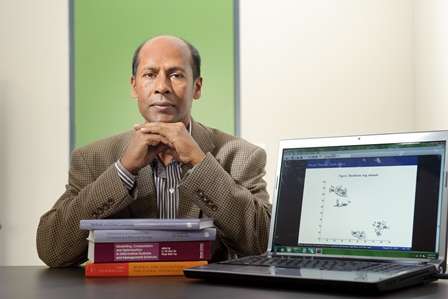"I was trained as an applied mathematician with a strong emphasis on statistics as a student at Dhaka University, Bangladesh. It transpired that this is not a common combination and I then went on to do my PhD at Loughborough University in Leicestershire in the United Kingdom on mathematical application solving engineering problems. Both these choices proved fruitful in my career, which brought me to Wits University in 1997," says Professor Montaz Ali.
A specialist in mathematics in industry, he has contributed top-end mathematical modelling to systems thinking and engineering in a range of industries, and published phenomenally on this during 2013 – the first year of the Wits Transnet Centre of Systems Engineering (TCSE).
"At the beginning of 2013 I moved from the School of Computational and Applied Mathematics to the TCSE for five years because they needed someone with engineering and mathematical experience to help solve Transnet's systems engineering problems," Ali explains. "I now spend 80% of my time here and 20% in the School of Computational and Applied mathematics, where I lecture a course in applied mathematics."
At the TCSE he is part of a team of 10 – half are academics, half are from industry – working on a number of key logistical problems to help Transnet improve the efficiency and day-to-day running of its many operations.
"One problem I am looking at is how to streamline the many upstream and downstream activities at the port terminal in Richard's Bay, which is the second largest port terminal in the southern hemisphere.
"Richard's Bay has been experiencing operational inefficiencies where there are too many logjams in the scheduling of the on-loading and offloading of ships, with associated problems of storage space at the terminals. This is not only an efficiency problem; it is hugely costly in terms of time and money wasted," explains Ali who is also looking at ways to extend the Richard's Bay port terminal in a meaningful and efficient way.
Another area that Ali is working on for Transnet is how to manage the fleet of locomotives and wagons in an efficient way, including how to work out when the fleet should be upgraded repaired or replaced; determining the optimal fleet size as well as improved turnaround times.
As part of both these areas and other TCSE research areas, researchers at the TCSE are also looking at developing methods for carbon footprint assessments.
Ali is central to the solution because mathematical algorithms are applied to optimise design efficiency in each one of Transnet's problems and requirements, as they are in the many other industrial design sectors that he has assisted.
"In the telecommunications industry, for example, a decision engine is required which will be capable of suggesting optimum network configurations to the network designer such as the cost of the network, ability to expand the network, ability to meet the financial target, etc.
"In the glass manufacturing industry they aim to minimise waste in the production line.
"In the motor industry, mathematical algorithms are applied to optimise vehicle suspension to offer drivers a safer and more comfortable ride."
In 2013 Ali was one of the authors on a paper on vehicle suspensions systems, titled: "Differential Evolution-Based PID Control of Nonlinear Full-Car Electrohydraulic Suspensions," published in Mathematical Problems in Engineering.
The introduction to this paper reads: The evolution of modern instrumentation and control techniques has made semi-active vehicle suspension systems (SAVSS) and active vehicle suspension systems (AVSS) designs more promising. However, the biggest challenge remains the attainment of trade-offs between the conflicting performance criteria like suspension travel, ride comfort, road holding and vehicle handling.
"My research and published papers are in the many different variations of algorithms," Ali explains. "Part of this is pure mathematical research that does not talk about the practical application of algorithms, and is all about improving existing algorithms."
In this domain, Ali and Dr Barilee´ Baridam from the Department of Computer Science, University of Pretoria, co-authored a novel research paper published by Emerald Insight in 2013 titled: An investigation of K-means clustering to high and multi-dimensional biological data.
The purpose of this paper, as stated by the authors, "is to investigate further, the usefulness of the K-means clustering in the clustering of high and multi-dimensional data by applying it to biological sequence data."
Clustering, as they explain in the introduction, "is a statistical concept that has to do with the problem of identifying interesting distribution patterns and similarities between objects in a data set (Berkhin, 2002; Binder, 1977). It is an optimisation problem that seeks to classify objects based on their proximity to one another."
"Then there is the applied side of mathematics where algorithmic design is applied to optimise best practice in industry," explains Ali who, for the past 12 years, has been part of the Mathematics in Industry Study Group at Wits, led by Professor David Mason.
The popularisation of the use of mathematics in algorithmic design dates back to World War II when mathematicians were called in to help design the logistics required to mobilise the armies more efficiently. Algorithms were developed to help industry ever since.
In addition to his research for the TCSE, Ali is supervising several PhD students who are using algorithmic design to solve a variety of problems. "One is for a company that collects money and sensitive materials from a bank. They need a collection route designed for them so that criminals cannot detect a pattern," he explains. "Another is to do with the scheduling of commercial aircraft flights for maximum efficiency and minimal cost. These flights are all over the world, so you have to work out a very precise schedule with the right number of well-booked flights to multiple destinations."
More information: "Differential Evolution-Based PID Control of Nonlinear Full-Car Electrohydraulic Suspensions." Mathematical Problems in Engineering 09/2013; 2013. DOI: 10.1155/2013/261582
Provided by Wits University
























